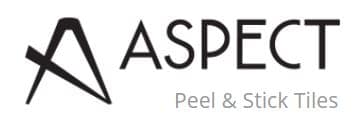Matted Glass Tile Installation
Tools and supplies needed:
- Protective eye wear or safety goggles
- Measuring tape
- Straightedge or Speed Square®
- Pencil or other non-permanent marker
- Soft cloth
- Chalk line
- Level (2′ to 4′)
- Fine-grit sandpaper (400-600 grit) or emery cloth
- Latex primer such as Zinsser® or KILZ® (or similar products, if method 1 is used)
- Caulk gun and caulk or Aspect® trim (optional)
If cutting tiles, one of the following tools will be needed:
If cutting tiles, one of the following tools will be needed:
- Wet saw with glass-cutting blade (recommended)
- Safety gloves
- Masking tape
- Glass tile nippers (two-wheel type)
- Simple manual glass cutter and oil
Before you begin
Installing Aspect peel & stick matted Glass tiles is a simple, exciting project that adds instant style to your kitchen or bath. We have deliberately over-explained the tile installation. Have fun with this project. It’s going to be easy and look great! Read this installation manual in its entirety before you start. If you have doubts about doing this installation, you should contact a qualified contractor, carpenter or professional installer.
Installation Methods
Method 1:
The adhesive on the back side of the Aspect matted glass tiles is engineered to stick to flat, primed, smooth walls. Allow the tiles and substrate to come to room temperature (65°F to 100°F) before installation. Use a heat gun or other source to warm the tiles and substrate if necessary. If you are using installation Method 1, proper wall preparation is required. Aspect can be installed over most structurally sound substrates if they are clean, flat, smooth, dry, and free of dust, wax, soap scum and grease. Acceptable substrates are drywall, plaster or clean, smooth tile (glazed, porcelain type tile; not porous or textured). Any damaged, loose or uneven areas must be repaired, patched, leveled and primed.
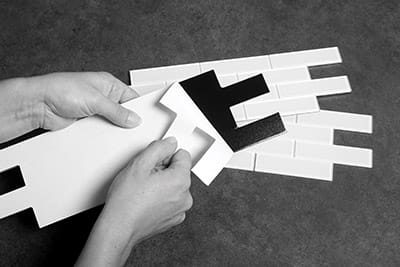
Method 2:
If you do not intend to prepare, sand and prime the surface, an additional adhesive should be used. We recommend a high-quality polyurethane construction adhesive be applied to the back of each tile in these cases. Apply some pea-sized dots of adhesive to the back of a full tile (see right). Keep the adhesive a half-inch from the edges. Firmly press the tiles into place. If adhesive squeezes out around the tiles, be sure to wipe it off before it dries.
Recommended Adhesives
Select a cutting method for cutting glass according to the shape of the cut that you want to make. Straight cuts can be made with a scoring tool. Compound intricate cuts should be made with a glass-cutting wet saw or by a professional glass shop. See Section 2 for more information.
There are many good guides about glass cutting on the web. Here’s a good Glass Cutting Article.
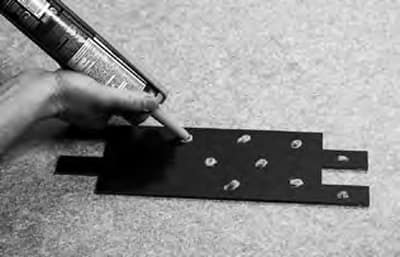
Layout:
Measure the first area to be covered by Aspect material. We recommend you lay out the entire project on a flat surface, like the countertop, a table or the floor, before adhering to the substrate, to be sure you have enough tiles and your design and layout is correct. This will also give you a good reference as to how the tiles will look on your wall. As each project is different, be sure to plan for cutouts, corners or edge treatments before applying tiles. One popular layout method is to begin from the inside corner of your counter and work across left to right. This method allows you to use two points of reference, your vertical wall and horizontal countertop. Note: when using these two points of reference, be sure to check them for level on the horizontal plane (Picture A) and 90 degrees plumb on the vertical plane (Picture B). This will prevent any problems as you build your backsplash. Lay a 4′ level on top of your countertop or backsplash return lip if you have one. If the counter is level, use it as your reference. If not, identify the high point(s) of the countertop. Draw a horizontal line using your level and snap a reference line to indicate the high point. Snap a reference line to indicate the top of the first row of tiles. The top edge of the first row will be installed along this line. Use a level or measuring tape to mark the vertical termination point of your installation.(Picture A) Use a level or measuring tape to mark the vertical termination point of your installation (Picture B). Measure the first area to be covered by Aspect material. We recommend you lay out the entire project on a flat surface, like a table or the floor, before installing to the substrate, to be sure you have enough tiles and your design is correct.
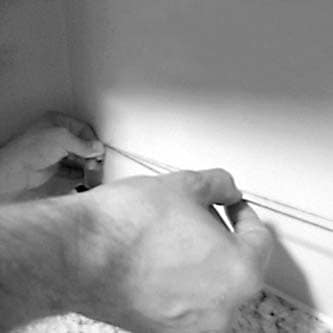

Installation
1) Installing your first tile: Here’s where the fun begins. Be sure the substrate is clean and dry. Align the tile where you want it on the reference lines. The aggressive nature of the adhesive does not allow for repositioning after pressing firmly. If it is in the right position, firmly apply even pressure across the entire tile. When applying subsequent tiles, first “dry fit” the tiles with the adhesive liner in place to ensure proper fit. Dry fit tile against the wall exactly where it will be placed. Install the next 3 to 4 subsequent tiles by light tacking or pressing them on the wall. At this time verify that the tiles are lining up straight and square. If they are you can firmly press on the tiles to secure them to the wall. If some of the tiles have come out of alignment you can work backward and remove the tiles using a putty knife. Then reapply the tiles making small adjustment to each tile to regain alignment. Place each section as if placing a puzzle piece (Picture C). Lightly place the tile onto the wall using your reference lines. DO NOT apply pressure to the tile until you are sure of your placement. (Picture D) DO NOT bend tiles backward as it could damage the tiles or permanently stretch and misshape the tile matting.
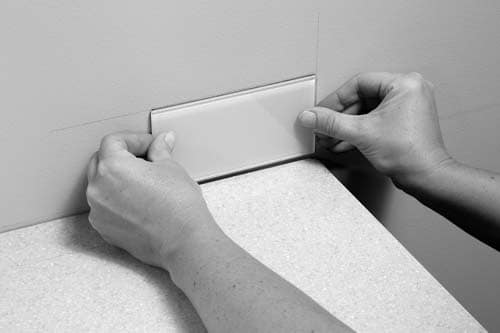
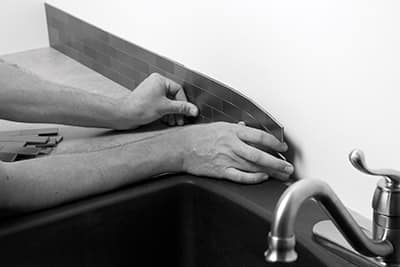
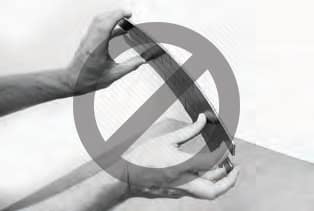
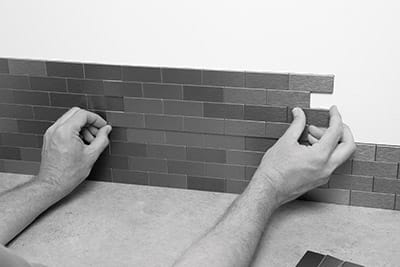
CAUTION: Do not stand or walk on release paper or a tile with release paper on the back as it is extremely slippery. Place it in a wastebasket immediately upon removal from tile.Do not skip ahead in tile section placement as alignment issues may occur; complete all tiles in a progressive manner. At the beginning and end of each row, cuts to one mat will be required to tie into the whole mats that are already installed. See cutting directions below.
2) Cutting tiles: When cutting the tiles use one of the recommended tools and methods listed above. A wet saw (Picture G) with a glass-cutting blade is the recommended cutting method. Alternative cutting methods include a glass tile nippers or a simple manual glass-cutting tool (Picture H). Measure where the cut must be made (Picture E). Map out and mark the cut using masking tape to cover the surface of the tile (Picture F). Cut the tile. Debur sharp edges with file or sandpaper. Take the cut tile to the work space and place it in its intended location, ensuring it fits properly. Cut and install all remaining tiles using the same steps described above. When tiles are installed to your satisfaction, press each again firmly with your hand. This will ensure that the adhesive bonds to the substrate. Allow 24 hours for the adhesive to set before exposing tile to a heat source (such as a stovetop or oven). Clean or touch-up tiles with glass cleaner and soft cloth or paper towels.
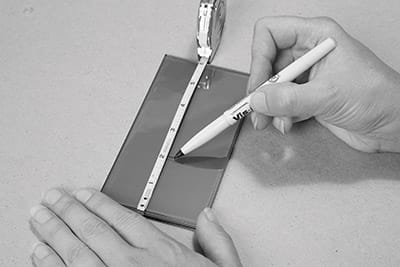
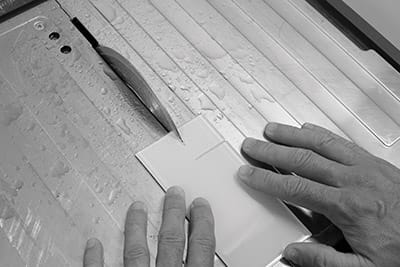
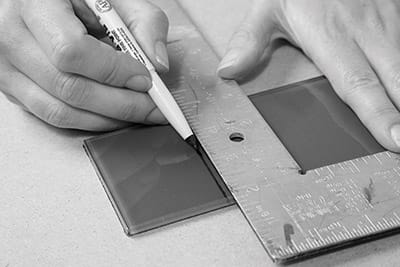

Tips and Techniques
Caulking countertop seam
If desired, apply a 1/8″ bead of caulk or silicone sealant in the gap under the bottom row. Wipe off excess sealant. Choose clear or colored caulk according to your preference.
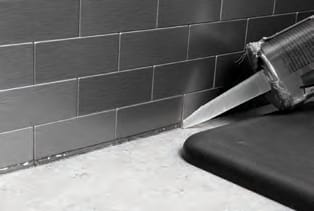
Edge Finishing
To finish the edges of your tile backsplash, Aspect trim is available online at DIY Decor Store. A second option is to seal the outside edges with caulk using the same materials and method used to seal the gap under the bottom row of tiles.
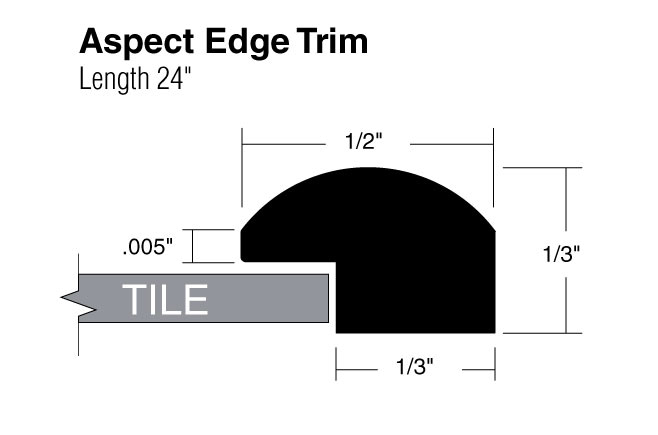
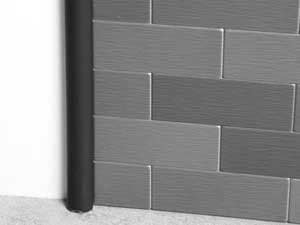
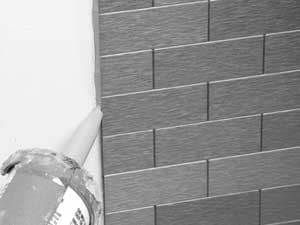
Adhering small pieces
Use tube adhesive for cut pieces of Aspect that are less than a third of a full tile.
Removing Tiles
If tiles need to be removed, use a putty knife and a heat gun or hairdryer to make the process easier. Note: By removing tiles, you risk damaging your walls and the tiles may be unusable.
Fitting Partial Tiles
To fit partial tiles, lay the tile to be cut exactly over the last full tile. Place another full tile against the wall and mark the cutting line where the tiles overlap. Cut tile on line. Before peeling the backing paper off self-adhering tile, check that the cut tile fits. Do not force it into place. Install tile (removing paper from self-adhering tile), and press tile firmly into position.
